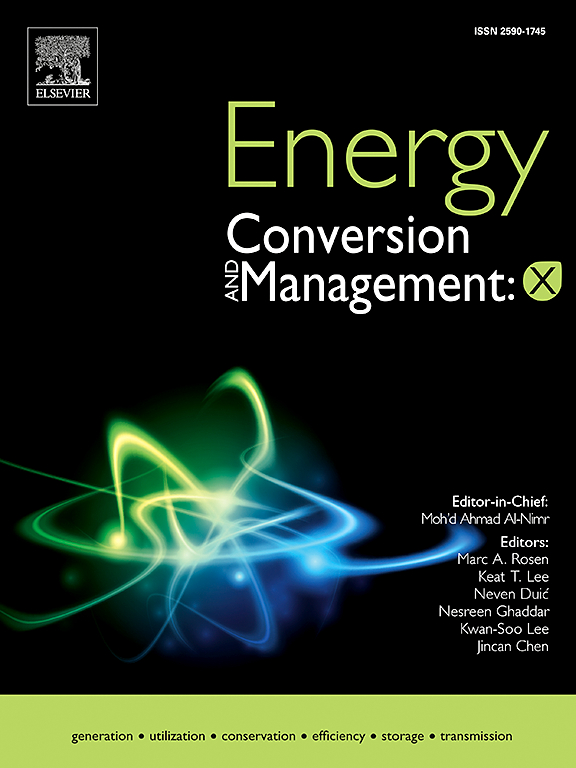不同流型下PEMFC双极板热管理策略的比较分析
IF 7.6
Q1 ENERGY & FUELS
引用次数: 0
摘要
矿物燃料储量的迅速枯竭及其对环境造成的后果促使人们寻找替代能源。质子交换膜燃料电池(pemfc)是最有前途的技术之一,具有超过60%的能量转换效率和零排放操作。然而,商业化受到水和热管理问题的限制,特别是在流场设计方面,这直接影响到性能、耐用性和效率。先前的研究已经确定,优化的流场几何形状可以通过改善反应物分布和除水来改善PEMFC的性能。然而,大多数研究只关注阳极侧或简化模型,很少有基于实验的定量验证。这项工作克服了这些限制,在一个有效面积为25 cm2的PEMFC上,对6种不同的阴极侧流场几何形状进行了广泛的三维计算流体动力学(CFD)模拟。通过极化曲线测量和温度测试对该方法进行了实验验证,压降和温度误差小于4%;温度预测精度6%。优化设计E的峰值功率密度为0.85 W cm−2,为参考设计A的峰值功率密度(0.58 W cm−2)的47.08%。设计E还显示,阴极出口的水饱和度降低了30%,氧浓度为0.212 mol/m3,比设计a提高了18.5%,并且表现出最小的压降,约800 Pa,最大温度均匀性和电流密度分布均匀性指数为0.79。其他优化的几何形状,B、C、D和F,通过在压降和水管理方面的各种权衡,平均功率密度提高了12.60%和20.00%。实验结果定量地表明,有意优化阴极流场几何结构可以显著提高PEMFC效率、水管理和热均匀性。经过验证的CFD方法是PEMFC系统未来设计和放大优化的可靠工具,特别是在汽车、航空航天和便携式电源应用中。该研究为下一代高效、耐腐蚀PEMFC流场的设计提供了一个全面的性能矩阵。本文章由计算机程序翻译,如有差异,请以英文原文为准。
Comparative analysis for thermal management strategies in the design of PEMFC bipolar plates using different flow patterns
The rapid depletion of fossil fuel reserves and their environmental consequences have catalyzed the search for alternative energy sources. Proton exchange membrane fuel cells (PEMFCs) are one of the most promising technologies, with efficiencies of over 60 % in energy conversion and zero-emission operation. However, commercialization is limited by issues with water and thermal management, particularly in the flow field design, which has direct implications for performance, durability, and efficiency. Prior research has determined that optimized flow field geometries can improve PEMFC performance through improved reactant distribution and water removal. However, most of the research has only been concerned with the anode side or with simplified models, with little quantitative validation based on experimentation. This work overcomes these limitations by carrying out an extensive three-dimensional computational fluid dynamics (CFD) simulation of six different cathode-side flow field geometries labeled A to F on a PEMFC with an active area of 25 cm2. It was verified experimentally with a polarization curve measurement and temperature test, having less than 4 % error in pressure drop and < 6 % accuracy in temperature prediction. The greatest peak power density of 0.85 W cm−2 of optimized Design E, or 47.08 % of reference Design A 0.58 W cm−2, pertained to considered designs. Design E also showed a reduction in water saturation of 30 % and an oxygen concentration of 0.212 mol/m3 at the exit of the cathode, 18.5 % higher than that for Design A. It also exhibited the lowest pressure drop, ∼ 800 Pa, and the highest maximum uniformity of temperature and current density distribution uniformity index of 0.79. Other optimized geometries, B, C, D, and F, achieved mean power density improvements of 12.60 % and 20.00 % with various trade-offs in pressure drop and water management. Experimental results quantitatively demonstrate that the intentional optimization of cathode flow field geometry can significantly enhance PEMFC efficiency, water management, and thermal homogeneity. The validated CFD method is a reliable tool for future design and scale-up optimization of PEMFC systems, especially in automotive, aerospace, and portable power applications. This research adds a comprehensive performance matrix that can be used to inform the design of next-generation, high-efficiency, corrosion-resistant PEMFC flow fields.
求助全文
通过发布文献求助,成功后即可免费获取论文全文。
去求助
来源期刊

Energy Conversion and Management-X
Multiple-
CiteScore
8.80
自引率
3.20%
发文量
180
审稿时长
58 days
期刊介绍:
Energy Conversion and Management: X is the open access extension of the reputable journal Energy Conversion and Management, serving as a platform for interdisciplinary research on a wide array of critical energy subjects. The journal is dedicated to publishing original contributions and in-depth technical review articles that present groundbreaking research on topics spanning energy generation, utilization, conversion, storage, transmission, conservation, management, and sustainability.
The scope of Energy Conversion and Management: X encompasses various forms of energy, including mechanical, thermal, nuclear, chemical, electromagnetic, magnetic, and electric energy. It addresses all known energy resources, highlighting both conventional sources like fossil fuels and nuclear power, as well as renewable resources such as solar, biomass, hydro, wind, geothermal, and ocean energy.
 求助内容:
求助内容: 应助结果提醒方式:
应助结果提醒方式:


